

Medicaid Program; State Plan Home and Community-Based Services, 5-Year Period for Waivers, Provider Payment Reassignment, and Home and Community-Based Setting Requirements for Community First Choice and Home and Community-Based Services. A.
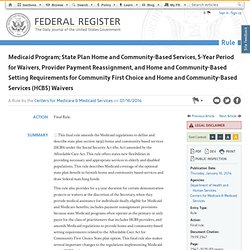
Background On February 8, 2006, the Deficit Reduction Act (DRA) of 2005 (Pub. L. 109-171) was signed into law. WorkWORLD™ Software Homepage. The WorkWORLD HELP/Information System is a comprehensive compilation of topics related to Federal and State work incentives and benefits.

The software is a useful resource for people with disabilities, advocates, work incentive and benefit counselors, and others seeking help finding employment-based paths to higher net income through the best use of Federal and State work incentives and benefits. Accessible from its Table of Contents, Index, or by Searching for any word in a topic, the Help/Information System is also extensively hyperlinked to allow for instant jumps back and forth between related topics.
The HELP/Information System can be used alone or concurrently with WorkWORLD for the Web, a separate application that takes into account the complex interaction of earnings, benefit programs, and work incentives to provide individualized recommendations for safe options as well as alerts to possible problems. Medicaid.gov. Waivers are vehicles states can use to test new or existing ways to deliver and pay for health care services in Medicaid and the Children's Health Insurance Program (CHIP).
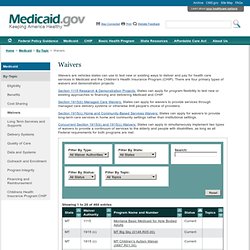
There are four primary types of waivers and demonstration projects: Section 1115 Research & Demonstration Projects: States can apply for program flexibility to test new or existing approaches to financing and delivering Medicaid and CHIP. Section 1915(b) Managed Care Waivers: States can apply for waivers to provide services through managed care delivery systems or otherwise limit people's choice of providers.
HCBS-setting-fact-sheet. Home & Community Based Services. HCBS-1915stepscomplianceflowchart. CMS Releases Home and Community-Based Services Compliance Toolkit. Rebecca Farley Director, Policy & Advocacy, National Council for Behavioral Health.
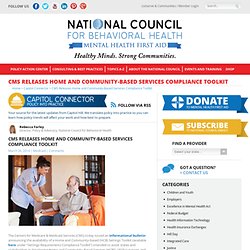
Olmstead: Community Integration for Everyone. Olmstead: Community Integration for Everyone The story of the Olmstead case begins with two women, Lois Curtis and Elaine Wilson, who had mental illness and developmental disabilities, and were voluntarily admitted to the psychiatric unit in the State-run Georgia Regional Hospital.

Following the women's medical treatment there, mental health professionals stated that each was ready to move to a community-based program. However, the women remained confined in the institution, each for several years after the initial treatment was concluded. They filed suit under the Americans with Disabilities Act (ADA) for release from the hospital. The Decision On June 22, 1999, the United States Supreme Court held in Olmstead v. The Supreme Court explained that its holding "reflects two evident judgments.
" Faces of Olmstead The personal stories of a few of the thousands of people whose lives have been improved by the Olmstead decision and the Department's Olmstead enforcement work. Full Story Full Story. Home and Community PAS Based Programs. About this project Recent studies have begun to describe the breadth and depth of Medicaid Home and Community Based Services (HCBS) programs more fully and although HCBS expenditures have increased rapidly from 1992 through 2006, states are facing serious budget problems which can jeopardize access to and funding for HCBS.
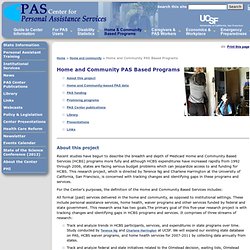
This research project, which is directed by Terence Ng and Charlene Harrington at the University of California, San Francisco, is concerned with tracking changes and identifying gaps in these programs and services. For the Center's purposes, the definition of the Home and Community Based Services includes: Medicaid Benefits Data Collection. Nasuad.org. Robins%20Presentation. Introduction. NPM_HCBS_2014. Families USA: The Voice for Health Care Consumers. Self-Direction. My Voice, My Choice, Idaho’s self direction program, is an option under the Developmental Disabilities Waiver.
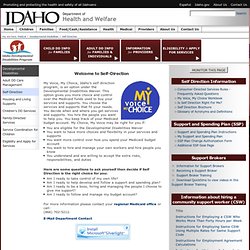
This option gives you more choice and control over the Medicaid funds used to buy your services and supports. You choose the services and supports that fit your needs. You decide when and where you get services and supports. You hire the people you want to help you. You keep track of your Medicaid budget account. Self Determination. Self-Employment Technical Assistance, Resources, & Training. Available formats: Word | PDF Medicaid Home and Community Based Services - May 2008 Medicaid is a state-federal program that provides health care to eligible low income individuals.
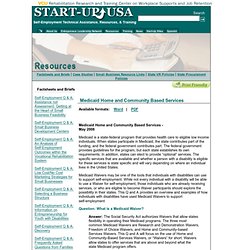
When states participate in Medicaid, the state contributes part of the funding, and the federal government contributes part. The federal government provides guidelines for the program, but each state establishes its own requirements. In addition, states can elect to provide “optional” services. Medicaid Waivers may be one of the tools that individuals with disabilities can use to support self-employment.
Question: What is a Medicaid Waiver? Answer: The Social Security Act authorizes Waivers that allow states flexibility in operating their Medicaid programs. Question: How does CMS determine if a Waiver should be approved or denied?